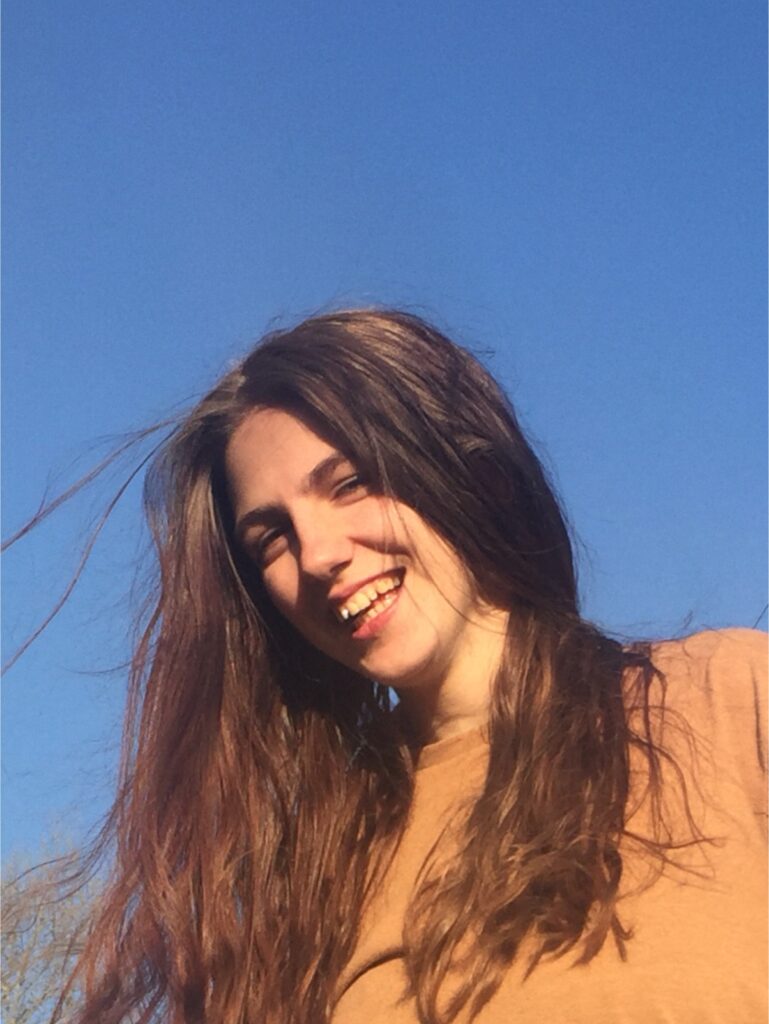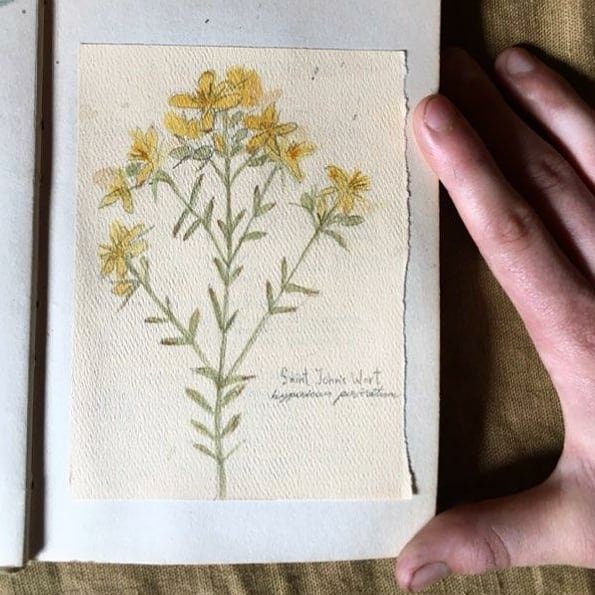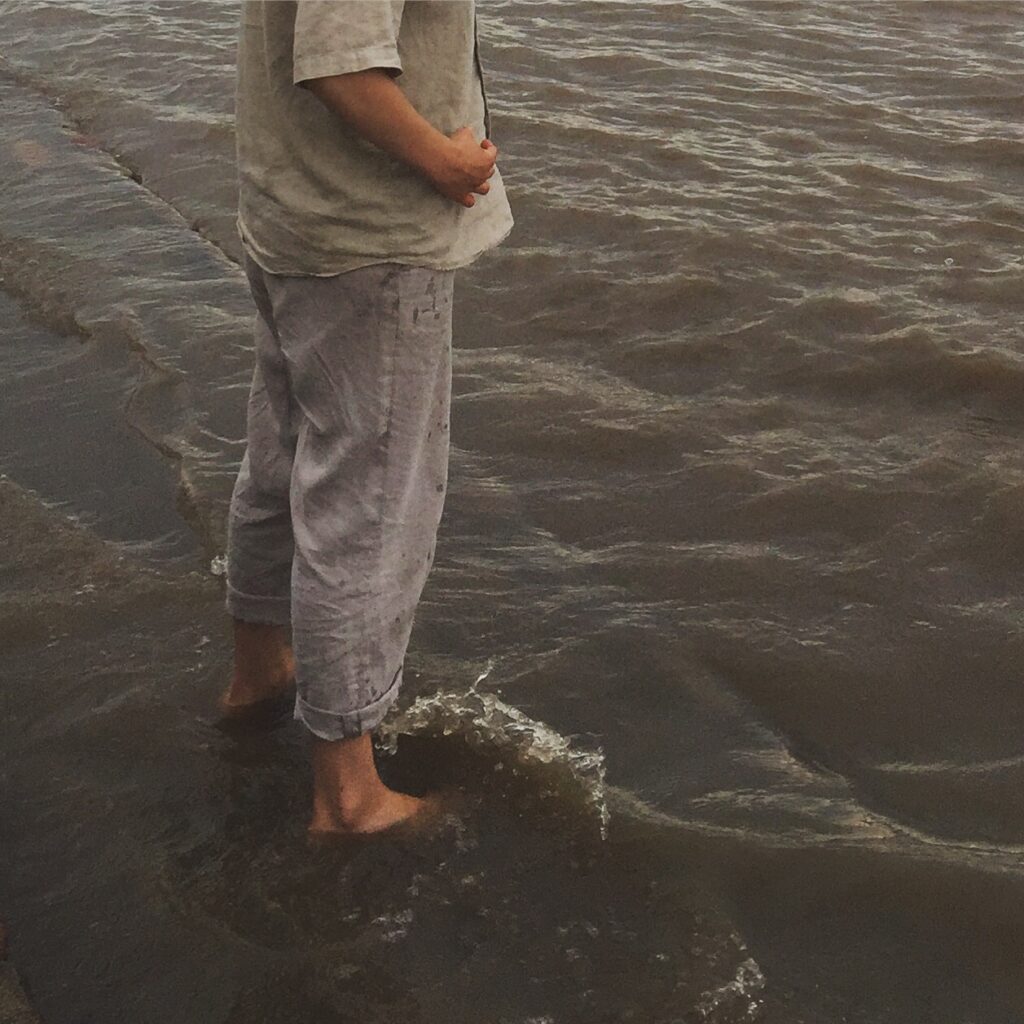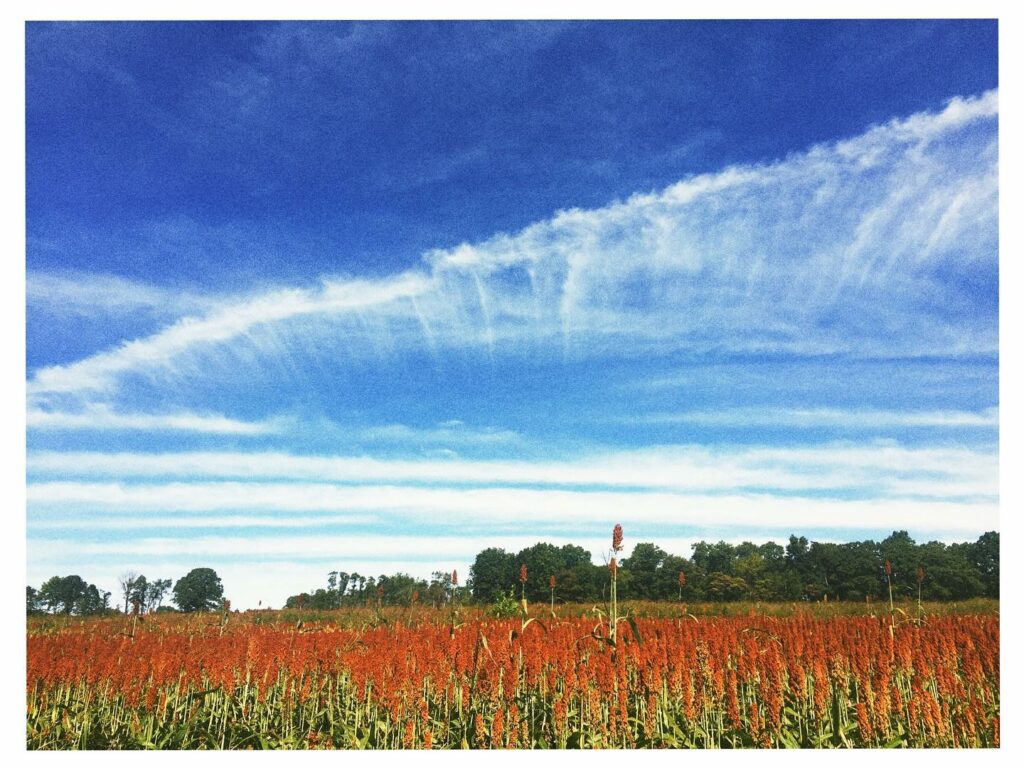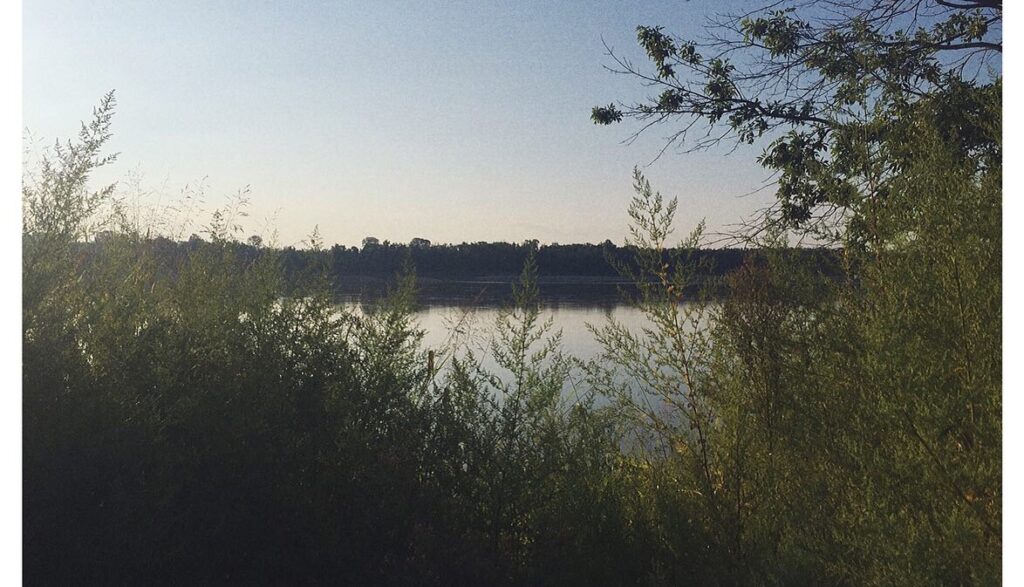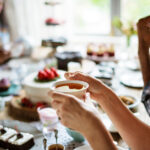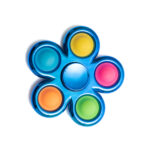Artist Rebecca Green doesn’t consider herself a photographer. She says she “dabbles” in many mediums, including oil and acrylic paint, ink and linocut; photography feels to her like using Crayons must feel to someone who isn’t used to drawing, reaching for whatever cheap material is available to doodle designs. Her equivalent to Crayons: She shoots photos on her iPhone 6 and uses the free app InShot to edit.
Yet, her images carry a quiet weight that, if you look, give the gift of feeling. They speak of a longing for something beyond ourselves, and they situate themselves squarely in the tangible before us, the horizon line ever shifted lower in the frame so our gaze is upward to the sky above the roofline of a house, the light reflected on a stream bed in the woods, an ecosystem of telephone wires above a being walking down the road; sometimes, our gaze lowered down to the earth, to the here and now, the necessity of tomatoes and mozzarella atop a crust cooking on a grill, the intricacy in the lines and curves of an indecipherable language printed on a spice bag in a market, a wave from the river lapping at ankles exposed below linen pants cuffed up so as not to get wet. On her Instagram account @re.becca_green, the images reside together, calling us to listen to the still, small voice that stirs inside us, that draws us ever forward toward the fullness we long for in the present by the pull of misty memory.
Here, we sit down with Green to talk about what art is, her artmaking process, and the ways she thinks about beauty and ugliness. This conversation has been edited for clarity.
Mia Pohlman: What is your journey with photography?
Rebecca Green: Yeah, that’s a funny question, because I don’t really consider myself a photographer at all. To me, because I do a lot of other types of art, right, it’s kind of like playing with Crayons or something for me, it’s like a medium that maybe someone who’s not used to drawing [would draw] with some cheap material, because literally, I only shoot it on my iPhone 6 or something, and it’s like a free app that I use to edit it. So, I thought it was really kind of funny that you asked me [to be a part of this issue], actually, because I don’t consider myself a photographer. But yeah, I got Instagram a couple years ago, and at first, I was thinking I was going to put my art-art, like drawings, paintings, whatever [on it]. But I found it was a lot easier because I was really inspired, and I love nature; it was easier for me just to post what I was taking pictures of.
You said you don’t consider yourself a photographer; what kind of an artist do you consider yourself? What are the primary mediums you’re working in?
I work with a lot of different mediums. So I like oil, acrylic, ink, linocut. I mean, I dabble in a lot of things, so I shouldn’t compartmentalize myself. I think it’s really whatever people are affected by is what actually I am as an artist. I grapple with actually titling myself an “artist,” because I don’t know what that means, really. How do you qualify as an artist? But no, I think I make things.
That’s really interesting. How would you personally define what an artist is, then? Or what art is?
Mmm. What is art? I really love that question. And the other one, too. I’ll try to think about it for a second. Well, I think art is creating. The act of creating something that’s meant to be shared. And maybe it’s for yourself, too, but it’s a self-expression. I think we’re all inspired by creation itself, you know, God’s creation, the creator, so I think it kind of is a mark of our uniqueness as humans that we create art. So yeah, what is an artist? I guess a human. I don’t know if that’s like super-defined. Yeah.
I love that so much. I love that you said earlier an artist is someone who makes art, who creates. It’s like, yeah. You can have that title.
Yeah, I guess everyone can.
That’s true. With your editing, I feel like your photos carry such emotional weight. Even just looking at them, they cause me to feel — I don’t know if I can exactly describe it, but — nostalgia isn’t quite the right word. Maybe like longing? But at the same time, love. Also, I feel they’re very place-based, as well. Whenever you’re editing, what is your approach to editing and how you go about doing that?
First off, thank you. That’s really sweet. And also, yeah, that’s a really good question. I think for me, I want to capture what I felt when I was in this place or what I am thinking of in the moment. Like, I do have a lot of thoughts while I’m creating something, and I think the biggest one is to make something beautiful. You know, I want to make it beautiful. And yeah, I think what you said about longing, that’s cool. I think, yeah, there’s a thought there that I want people to remember, or I want myself to remember, maybe, just what was good here. Yeah. So again, I don’t use a fancy editor. It’s an Instagram editor called Inshot that I downloaded, and it works pretty good for me. I add a lot of layers of stuff like exposure. I adjust it, I’ll add some filters or crop it or whatever to get kind of the mood that I’m looking for.
That’s a good word for it — it does have this emotional depth that definitely comes across with it. How do you know when you’re finished with that process?
Umm, when it feels right. I don’t know; when it captures what I feel like that experience was. I actually take a lot of pictures on the walks that I go on with my mom. We have a gravel road near our house, and it’s like in the country, right? So it’s a really pretty area, and I have a lot of memories there. Because I live in Cape now most of the time, when I actually go back, it’s a place of beauty and quietness and rest and memories, notalgia. And nature is like that for me, and I also take a lot of pictures by the river, which is where I go in Cape to find that nature, that calming, quietness. Just kind of looking at God’s creation, it kind of helps center me. Because I feel like I’m an adult now and busy and there’s stuff going on, so to kind of remember that.
What do you think it is about nature that inspires you?
Mmm. I love that question. Again, I think beauty is big. Order is another. Just seeing the completeness and the intricacies of nature. I get these thoughts of kind of like Adam and Eve in the garden, Garden of Eden, sort of, this kind of where we were — come from, I guess. So I guess it’s kind of that sort of feeling of being a part of the world and what we’re supposed to be. So yeah, it helps remind me of things. Of importance.
What kinds of things of importance?
Umm, I think on one hand, especially the river reminds me of my smallness and also where I am in time and how this water has been moving for years and years. I guess it reminds me of God. And I think just being in that, being a part of that, it puts me in my place again. And that’s helpful. That’s a beautiful thing, I guess, for me.
I love, too, this idea of place. Because I feel like when I look at your photos, that’s definitely something that is so present in all of them: They are photos about place. I don’t know if I have a well-formed question about that, but can you just speak a little bit to why you’re drawn to place and your connection with that?
Great question. Place being defined as place being separate from another place? Is that what you mean? Like, I choose different places?
Yeah, I guess. That’s a good question; what do I mean by place? I guess they just seem very rooted in the tangible. They’re about place, they’re about this specific place that you’re in, in that moment. Which I guess you could argue all photography is, but your photos almost seem like that is what the main point of them is, is like, ‘Look at this place where I am, right now in this moment.’ I don’t know, and maybe that’s not true, maybe that’s me projecting my own assumptions and thoughts onto it, but I just feel like setting is very heavy in your photos and in your work.
That’s cool. Sometimes, you know, when you’re making something and you’re representing something, it’s true, you’re maybe not thinking of that aspect of it. Yeah, I don’t know if I’ve thought about that so much, but I guess it’s just thought and seasons. That’s kind of a theme of my life and the things that are affecting me right now, whether it’s the river or the fall or the spring or the winter, and just kind of seeing the beauty here, right now. And it’s not like everything is perfect, you know, there’s some messy edges and stuff, and it’s just being in this place, and there’s good here. And there’s good to have hope, have hope in growing in that, in the soil.
I’m interested, too, with growing up in a rural area and in small towns, do you think that kind of affected your noticing of or perception of the seasons? And then if so, how has that changed with moving to Cape? Not that this is an urban area, but being in a place that is a town or a city.
Yeah, that’s a good question, too. Yeah, I think that I realize more what I lack when I am returning to the rural area. But I definitely think that living in the country for most of my life, it’s affected how I view nature. Because it was always, like, exploring. Even though we lived in kind of a — I wouldn’t call it a dump, because I love the place, OK, but some people would see where we live and the area where we live as kind of a dump. So, you kind of have to push back some levels sometimes to actually see what is beautiful in this area, and especially, I think, the only ugliness that really is to be found is what people are doing with nature, I think. So like, littering and stuff or making roads or stuff … anyway. I’ll save that for another time.
No, that’s great. We can talk about that if you want.
All those environmental issues. But no, I think in spite of that, I still love it, and in spite of the people, in spite of the people imprints in the place, whatever it is, I still love the place. And even like, I did have a photograph of this torn-down building, it’s a house, like a junkyard house, and that’s on the road, too, and it’s got a tree there, and it’s kind of scraggly … and I think it’s just where it’s at, it’s reality. And I think at one time, this house is in the middle of the country, and it’s actually surrounded by what was a junkyard where people burned tires. And it just wrecked the land. It was a while back. But … this house, you could tell at one time, it was a beautiful house. And at one time, down the hill from the house, there was a stream, and so it’s an old house probably where they actually had houses by the water. So anyway, you can see all that, and you can say, there was some beauty here, and maybe there will be again. And maybe I can be a part of that in some way, maybe. Or maybe in another place. There’s tons of places like that.
That’s really interesting. How do you define beauty, and how do you define ugliness?
Great question. We’re really on a roll. You know, I think it really all stems back to the original order of creation and the beauty and the harmony, harmony and unity with the creature and creation and the creator, as well. So I think like for me, I know in this world, it’s not like you’re exempt from death and suffering and all those things, and I think, in a sense, really, those can be beautiful, too. I definitely think there’s a dignity and grace and beauty that God gives us in those things. I think maybe the ugly, the only ugly, is really from sin and our choice in that, and the exploitation, the harm, the going against what is beautiful of that, of the unity and the harmony, going against and warring against the creator and the created. I think to me, that’s kind of what it is. I think because of the state of sin, there is death and suffering, but you know, that isn’t the problem, really. … So that’s maybe why I can also see beauty in a broken house. And it’s not so much the thought that the things that made this house broken was beautiful, no. But the things that can make this house whole again are.
That’s beautiful. Whenever you’re composing your photographs, what are you thinking about? How do you compose?
Oh, man. I guess if the scene looks memorable and like a memory to me, then I want to capture that. Especially if something is just really beautiful and unique, maybe, too. Otherwise, it’s usually just because I have my phone with me. Sometimes, I forget it, and those pictures are for my mind alone, I guess, the ones that I capture without a phone.
I think it’s interesting, too: A lot of times when there are people in your photos, it’s only part of them. Can you talk a little bit about that and what attracts you to compose in that sense?
Yeah. I don’t know all the reasons that I do that, but I think one of them is so that you can kind of fit yourself in the picture. And it has a sort of ambiguity for the viewer and like, I can be there, too. And it’s interesting, because when I draw and paint, it’s usually strictly, solely, people. And sometimes, very close-up. So yeah, when I take pictures, it’s not usually like that. It’s just different.
What makes you choose photography, and when do you choose other mediums like painting or drawing?
I think what it is for me is maybe the quickness of it, like, you’re able to capture a moment so quickly. And sometimes in the summer, which I probably will do again, because I really enjoy it, I took up a habit of painting, like watercolor by the river really quickly, like five minutes or 10 minutes, which I enjoyed a lot. But when you have a picture, it’s just a different medium. Like, I could get some strokes in before the light changed, but it’s a different sort of capturing. It captures a little more full and clear, too. It’s more fleeting with paint.
What do you try to convey through your photos, and why is that important to you?
These questions make me happy. Again, beauty, really. Kind of sums it up. But yeah, the order, the goodness of creation. And you know, I think a little bit of a metaphor, too. Like, I take pictures of landscapes and stuff, and broken houses, but I think in a sense, I’m wanting them to be a reminder for myself, too, that I am the field, you are the field. You are God’s field. And to see yourself kind of mirrored in your surroundings in nature. The nurturing, the care — that I want to take care of a plot of land, for example, that’s really a reminder for a human. … It’s really about the human, because we’re broken people, we’re neglected fields, sometimes. And I think there’s hope that I also want to portray in my photos and my art, in general. The hope to grow that, nurturing.
Why is it important for you to show that hope through your art?
I think it’s really for me as a reminder, you know. And also for other people, too. You know, that they can see it.
Can you talk a little bit about your captioning on Instagram, too, and how you pair your written text with the visual image and how you think about that?
Umm, you know, on Instagram, I do try to be pretty sparse.
Yeah. I love that. It’s very poetic.
Thanks. Because I just want to get one thought across. And it’s interesting, like, I’m not a very wordy person, so maybe that has something to do with it, too. It’s not like I have a lot of word thoughts going out. But it’s really just like this is concise, this is complete. And that’s what the caption is kind of to tie that in, this thought. And also what I’ve been thinking about, like whenever I post verses from the Bible or a quote from a book or something, it’s just something that’s really been pressing on my mind, and I’m trying to kind of condense it into one journal entry, almost.
I love that. I feel like a lot of the tones are more muted, too. Can you speak to that? I guess that kind of goes back to the editing question we talked about earlier.
Sure, yeah. Like kind of a moody tone, you mean? Umm, I guess ‘cause I’m moody. No. <laughs> That’s true. Sometimes, I’ll flick through my photos, I’m like, ‘Oh my gosh, these are really moody.’ I don’t know if I’m totally that moody. I don’t know, I think they’re sort of like I am hiding myself a little bit, because there’s a question for me that I’ve kind of grappled with a lot because I haven’t been a social media person for a long time. For purposes, right? So, it’s like, how do you show yourself on social media? How do you portray, like, it’s not reality, really, you’re not really seeing the whole of my person, of who I am, how do you approach that? There’s many different approaches, but one that I chose is kind of not too super personal, but at the same time, I think it does reveal something about who I am, just in a different way.
That’s so interesting; I love that. What do you feel like it reveals about who you are?
Umm, maybe I’m a little odd. <laughs>
I don’t think so. <laughs>
Uhh, maybe I like nature? And could be like, ‘That person’s moody.’ I don’t know. But really, I think what I hope it portrays is that I’m kind of wanting the message, if you will, to kind of speak louder than myself. So I don’t want people to be looking at myself. Like, in normal person interaction, that’s part of it, that is the point, you know? Getting to know a person. But because this is different, I think it’s a little more unhealthy if you put yourself out there in that way, and I don’t know, just thinking about that.
Is there anything else that you would want people to know or that we haven’t talked about yet?
Umm, I’m not sure what would be a topic that would be good. I don’t know. I’ve said too much already.
